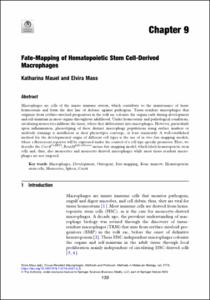Mauel, Katharina; Mass, Elvira: Fate-Mapping of Hematopoietic Stem Cell-Derived Macrophages. In: Tissue-Resident Macrophages: Methods and Protocols. New York: Springer, 2023. 139-148.
Online-Ausgabe in bonndoc: https://hdl.handle.net/20.500.11811/11068
Online-Ausgabe in bonndoc: https://hdl.handle.net/20.500.11811/11068
@inbook{handle:20.500.11811/11068,
author = {{Katharina Mauel} and {Elvira Mass}},
title = {Fate-Mapping of Hematopoietic Stem Cell-Derived Macrophages},
publisher = {Springer},
year = 2023,
month = aug,
booktitle = {Tissue-Resident Macrophages: Methods and Protocols},
volume = 2713,
pages = 139--148,
note = {Macrophages are cells of the innate immune system, which contribute to the maintenance of tissue homeostasis and form the first line of defense against pathogens. Tissue-resident macrophages that originate from erythro-myeloid-progenitors in the yolk sac colonize the organs early during development and self-maintain in most organs throughout adulthood. Under homeostatic and pathological conditions, circulating monocytes infiltrate the tissue, where they differentiate into macrophages. However, particularly upon inflammation, phenotyping of these distinct macrophage populations using surface markers or antibody stainings is insufficient as their phenotypes converge, at least transiently. A well-established method for the developmental origin of different cell types is the use of in vivo fate-mapping models, where a fluorescent reporter will be expressed under the control of a cell type-specific promoter. Here, we describe the Cxcr4CreERT2; Rosa26LSL-tdTomato mouse fate-mapping model, which labels hematopoietic stem cells and, thus, also monocytes and monocyte-derived macrophages while most tissue-resident macrophages are not targeted.},
url = {https://hdl.handle.net/20.500.11811/11068}
}
author = {{Katharina Mauel} and {Elvira Mass}},
title = {Fate-Mapping of Hematopoietic Stem Cell-Derived Macrophages},
publisher = {Springer},
year = 2023,
month = aug,
booktitle = {Tissue-Resident Macrophages: Methods and Protocols},
volume = 2713,
pages = 139--148,
note = {Macrophages are cells of the innate immune system, which contribute to the maintenance of tissue homeostasis and form the first line of defense against pathogens. Tissue-resident macrophages that originate from erythro-myeloid-progenitors in the yolk sac colonize the organs early during development and self-maintain in most organs throughout adulthood. Under homeostatic and pathological conditions, circulating monocytes infiltrate the tissue, where they differentiate into macrophages. However, particularly upon inflammation, phenotyping of these distinct macrophage populations using surface markers or antibody stainings is insufficient as their phenotypes converge, at least transiently. A well-established method for the developmental origin of different cell types is the use of in vivo fate-mapping models, where a fluorescent reporter will be expressed under the control of a cell type-specific promoter. Here, we describe the Cxcr4CreERT2; Rosa26LSL-tdTomato mouse fate-mapping model, which labels hematopoietic stem cells and, thus, also monocytes and monocyte-derived macrophages while most tissue-resident macrophages are not targeted.},
url = {https://hdl.handle.net/20.500.11811/11068}
}






